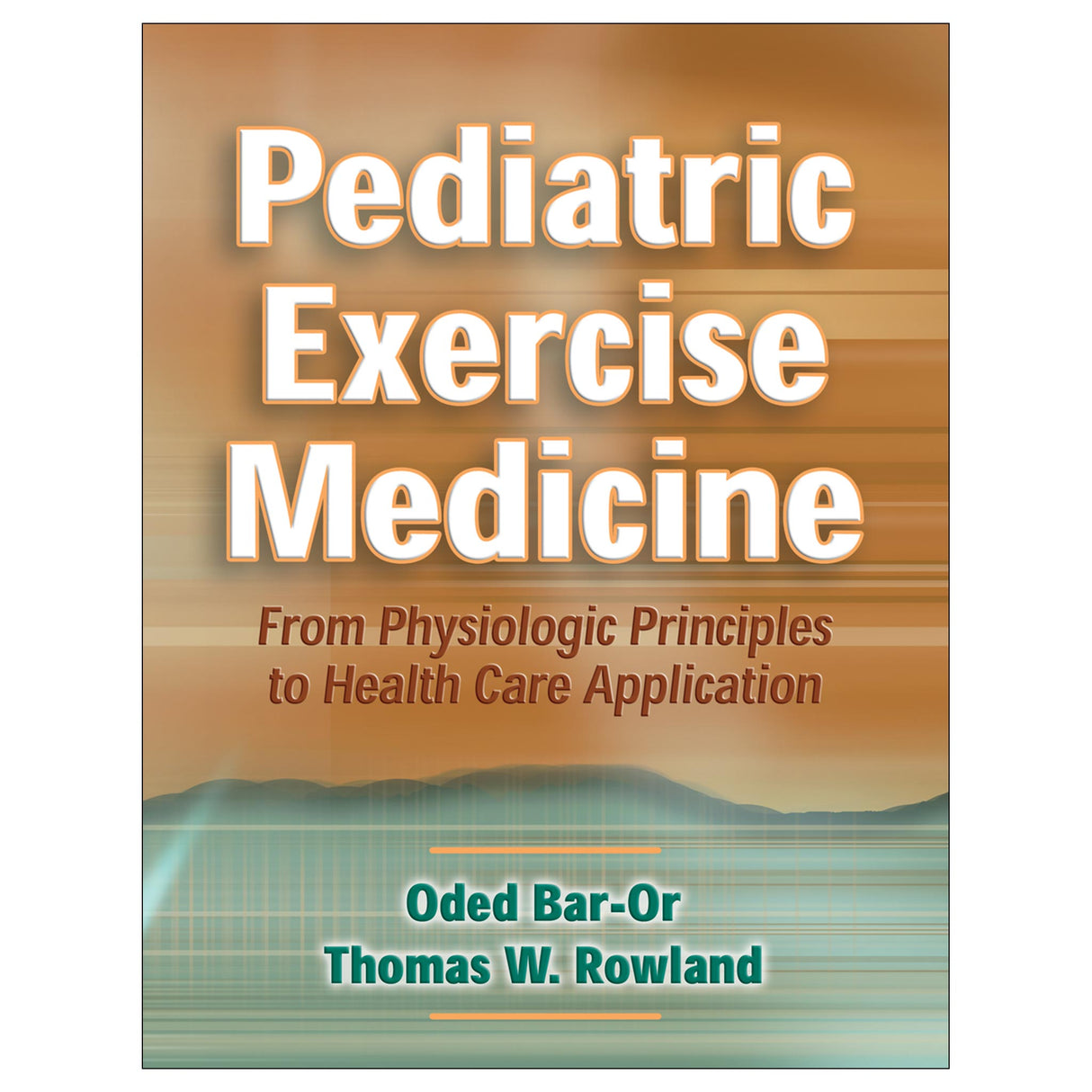Pediatric Exercise Medicine
From Physiologic Principles to Health Care Application
Author: Oded Bar-Or, Thomas W. Rowland
$69.00 CAD
Pediatric Exercise Medicine: From Physiologic Principles to Healthcare Application draws from the most current research activity in the area to examine physical activity as a prerequisite to the good health and physical performance of children. The book also considers the effects of lack of exercise on children and the relevance of exercise to clinical pediatrics for children with chronic diseases.
While Pediatric Exercise Medicine: From Physiologic Principles to Healthcare Application emphasizes clinically related issues, it provides comprehensive coverage of the child-exercise-health triad of importance to all professionals serving young people. The text identifies current research in the area of pediatric exercise. It also helps the reader to compare the exercise responses of healthy children to the responses of children with clinical impairments. In turn, readers will recognize the factors that can influence children's activity behavior, trainability, and performance.
The book contains three chapters related to the normal physiological and perceptual exercise responses of the healthy child. The next nine chapters consider the effects of exercise on children with clinical impairments, including asthma, diabetes, cerebral palsy, and obesity.
A special feature is the coverage of children's trainability and the factors that can influence performance. The information, including environmental stressors on children, will be of interest to scholars and students as well as to coaches working in this area.
The book also has these features:
-Extensive graphic interpretation of the data—more than 250 illustrations
-Helpful reference tables
-Six appendixes on normative data, methods, energy-equivalent tables for different activities,scaling for body size, and a glossary of terms.
In Pediatric Exercise Medicine: From Physiologic Principles to Healthcare Application, you'll find content you can apply in your daily work as a therapist, exercise scientist, physician, or other professional. You'll also find evidence-based rationale for the need for physical activity as a preventive measure and treatment of disease in children.
Audience
Reference for exercise scientists, exercise physiologists, dietitians, pediatricians, physical therapists, psychiatrists, family physicians, and occupational therapists.
Part I: Exercise Physiology of the Healthy Child
Chapter 1. Physiologic and Perceptual Responses to Exercise in the Healthy Child
-Size-Dependent and Size-Independent Differences
-Metabolic Responses to Exercise in Children
-Maximal Aerobic Power
-Mechanical Efficiency and Economy Of Movement
-Anaerobic Exercise
-O2 Uptake On-Transients
-Recovery Following Exercise
-Morphologic and Functional “Specialization”
-Cardiovascular Response to Exercise
-Pulmonary Response to Exercise
-Effects of Growth and Maturation on Muscle Strength
-Effects of Growth and Maturation on Bone
-Prolonged Exercise
-Warm-Up Effect
-Perception of Exercise Intensity
-Immune Responses to Exercise
-Training
-Window of Opportunity for Trainability.
-Training and the Bone
-Physiologic Effect of Detraining
Chapter 2. Habitual Activity and Energy Expenditure in the Healthy Child
-Definitions
-Physical Activity and Physical Fitness
-Age and Maturational Changes in Physical Activity and Energy Expenditure
-Effect of Age on the Amount of Physical Activity and Energy Expenditure
-Gender Differences in Physical Activity and Energy Expenditure
-Tracking of Habitual Physical Activity
-What Is “Sufficient” Physical Activity?
-Factors That Affect Physical Activity in Children and Adolescents
Chapter 3. Climate, Body Fluids, and The Exercising Child
-Heat Stress and Heat Strain
-Heat Production and Heat Exchange
-Physiologic and Behavioral Means of Thermoregulation
-Geometric and Physiologic Characteristics of Children Relevant to
-Thermoregulation
-Sweating Pattern
-Effectiveness of Thermoregulation and Heat Tolerance During Exercise
-Physical and Physiologic Responses to Cold Climate
-Temperature Regulation During Swimming
-Implications of Cold Climate for Health
-Acclimatization and Acclimation to Exercise in the Heat
-Effect of Conditioning on Thermoregulation
-Fluid and Electrolyte Balance
-Health Hazards in Hot Climates
-Guidelines for the Conduct of Athletic Events in the Heat
-Guidelines for the Conduct of Athletic Events in the Cold
Part II: Clinical Perspectives of Children and Exercise
Chapter 4. Children and Exercise in a Clinical Context—an Overview
-Habitual Activity and Disease
-Disease as a Direct and Indirect Cause of Hypoactivity
-"Non-Disease" as a Cause of Hypoactivity
-Effects of Disease on Physical Fitness
-Hypoactivity-Deconditioning-Hypoactivity: The Vicious Circle
-Reduced Maximal Aerobic Power
-High Metabolic Cost of Exercise
-Exercise as a Diagnostic Tool in Pediatrics
-Beneficial Effects of Physical Activity to the Child with a Chronic Disease
-The Exercise Prescription
-The Need for Motivation
-Deleterious Effects of Exercise
Chapter 5. Physical Activity and Preventive Health Care in Children and Adolescents
-The Exercise-Health Link in Adults
-The Pediatric Rationale
-Exercise in Children and Risk Factors for Adult Chronic Disease
-Risk Factors and Exercise in Youth: Weighing the Evidence
-Tracking of Physical Activity
-Defining Exercise Promotion Strategies
Part III: Exercise and the Child with a Chronic Disease
Chapter 6. Pulmonary Diseases
-Asthma
-Bronchopulmonary Dysplasia (BPD)
-Cystic Fibrosis (CF)
Chapter 7. Cardiovascular Diseases
-Congenital Heart Disease
-Noncongenital Heart Disease
-Cardiac Exercise Rehabilitation Programs
-Risks of Exercise
-Cardiac Non-Disease in Children
-Complete Heart Block and Pacemakers
-Systemic Hypertension
Chapter 8. Endocrine Diseases
-Type 1 Diabetes Mellitus
-Type 2 Diabetes Mellitus
-Growth Hormone Deficiency
Chapter 9. Nutritional Diseases
-Anorexia Nervosa
-Obesity
-Undernutrition
Chapter 10. Neuromuscular and Musculoskeletal Diseases
-Cerebral Palsy
-Chronic Fatigue Syndrome
-Epilepsy
-Extremely Low Birth weight
-Juvenile Idiopathic Arthritis
-McArdle's Disease
-Myelomeningocele
-Muscular Dystrophy
-Scoliosis
Chapter 11. Hematologic, Oncologic, and Renal Diseases
-Anemia
-Hemophilia
-Bone Marrow Transplantation
-Exercise and Cancer
-Chronic Renal Disease
Chapter 12. Emotional and Mental Disorders
-Scope of the Problem
-An Overview of Exercise and Mental Health in Adults
-Studies in Children and Adolescents
-Summary
"This is an excellent and worthy successor to the original published over 20 years ago. It should have broad appeal for many different professionals in an area with few other comprehensive resources available."
Michael White, MD, PhD
Ochsner Clinic Foundation





